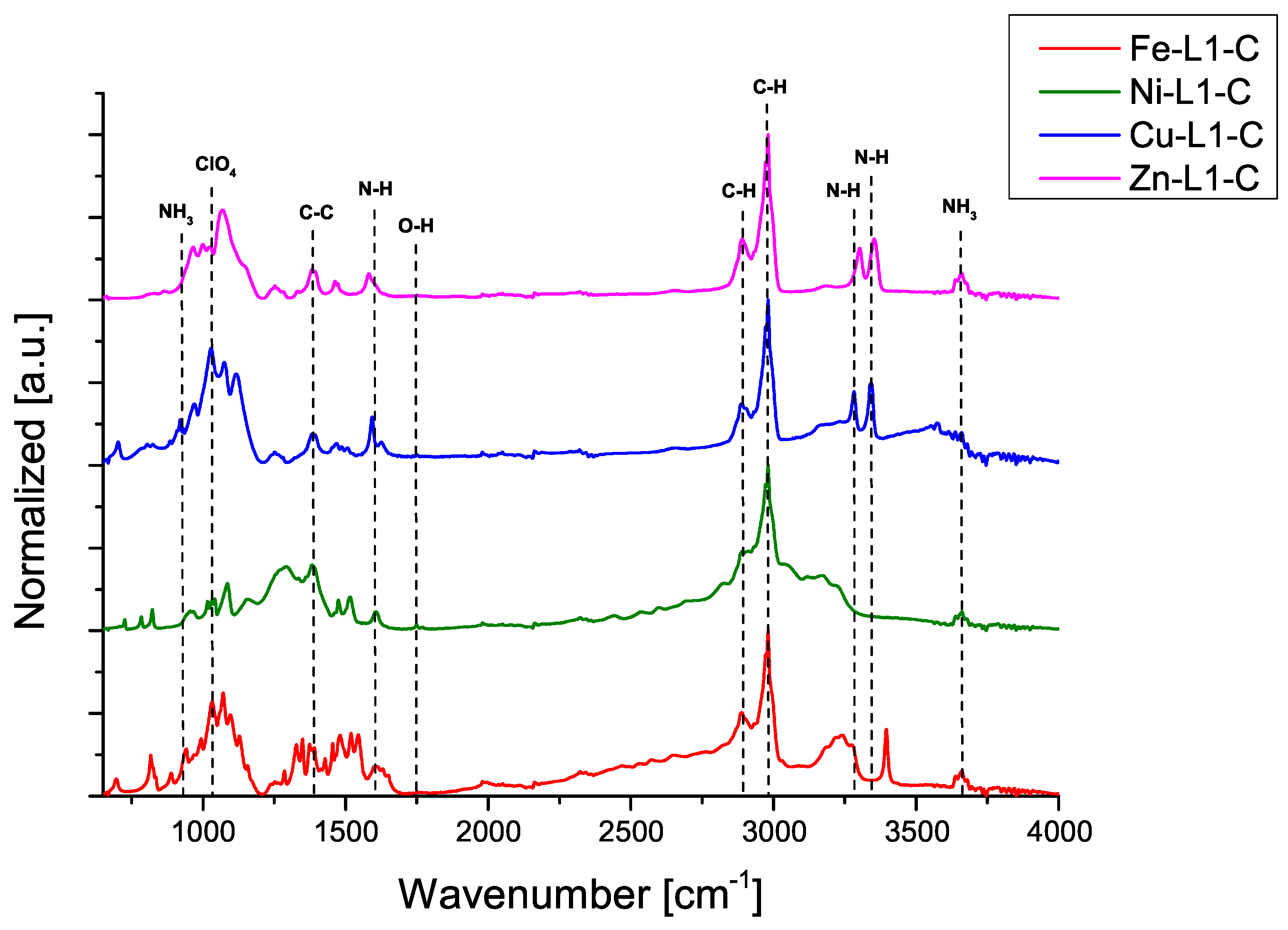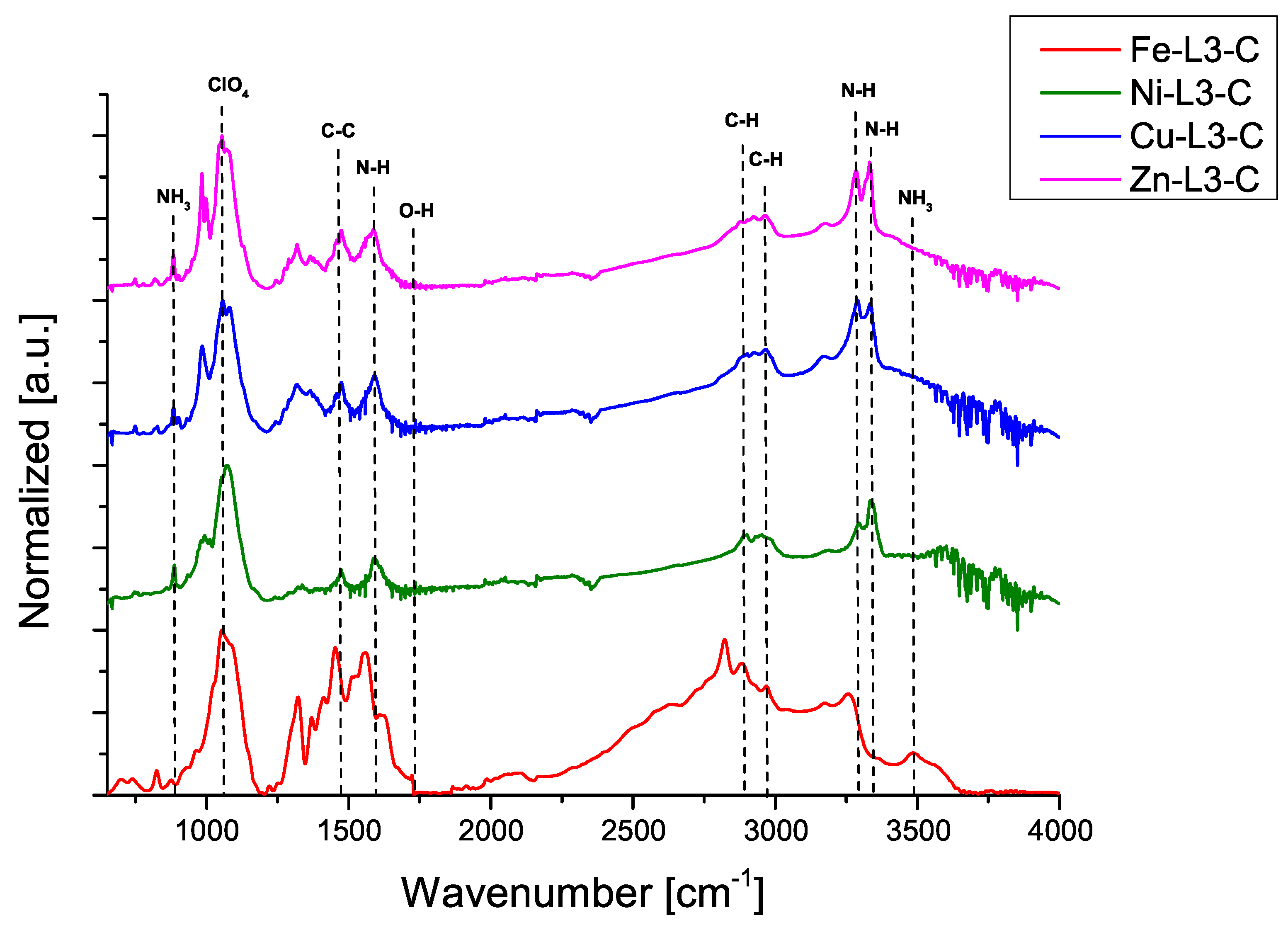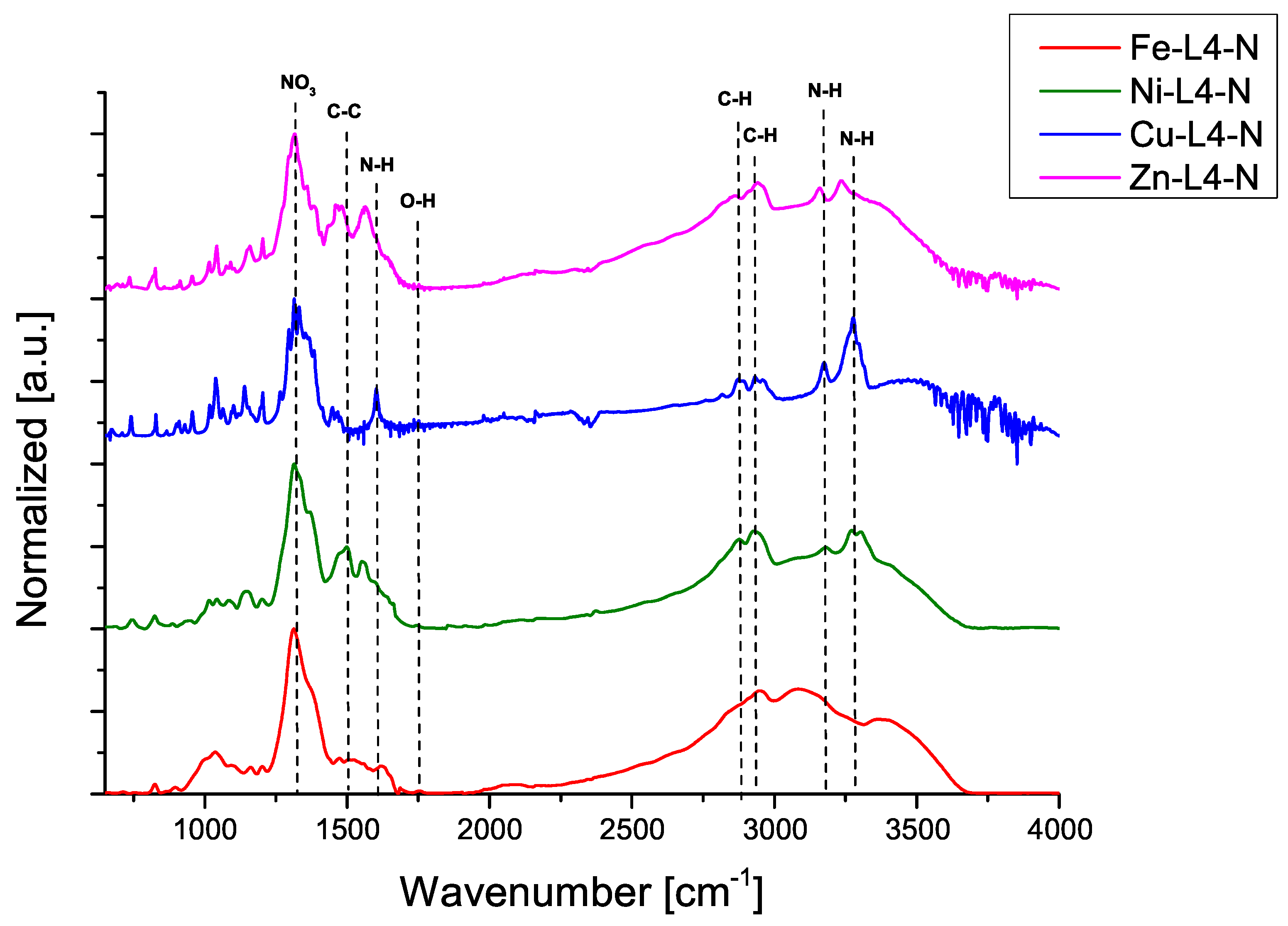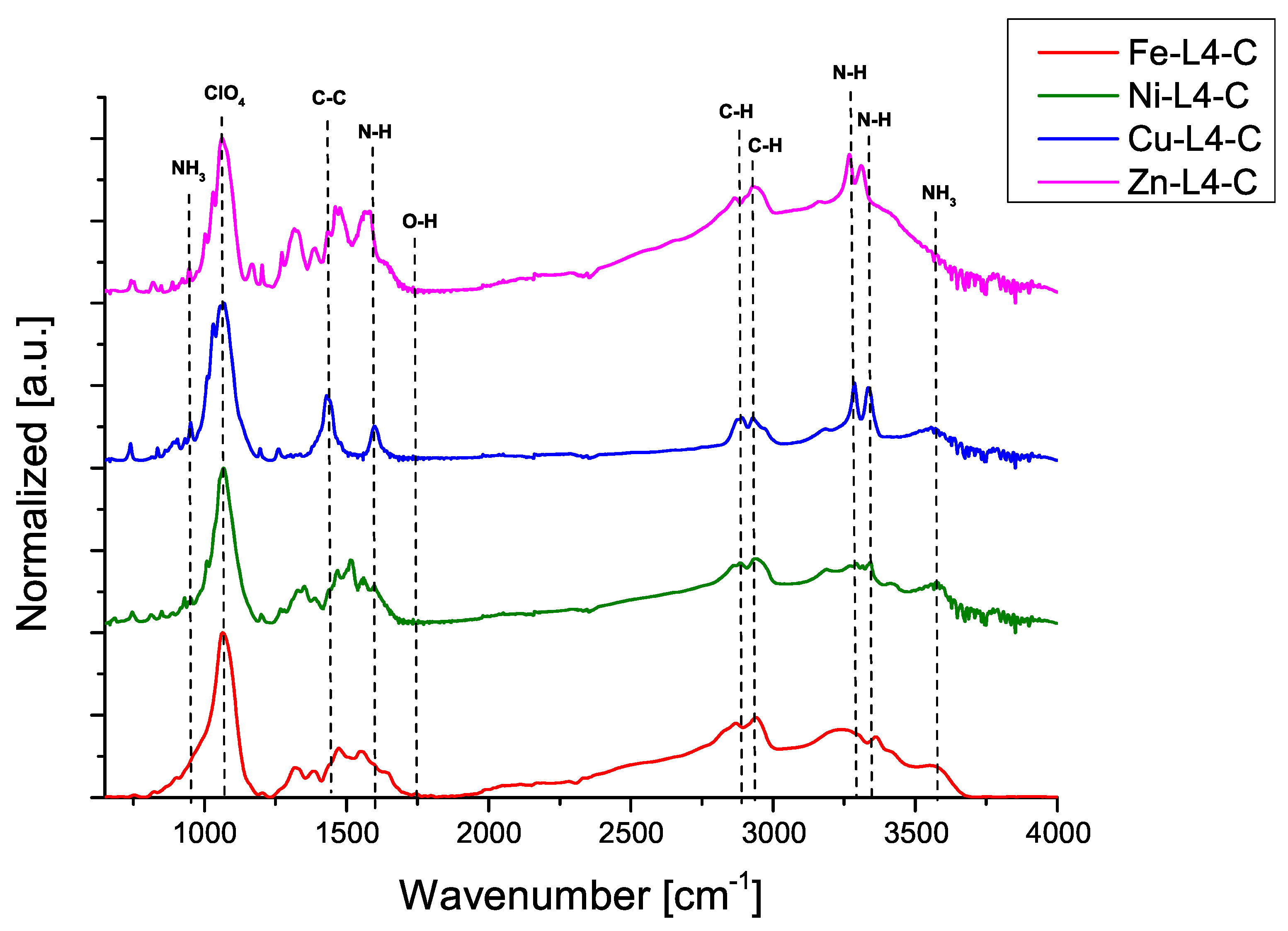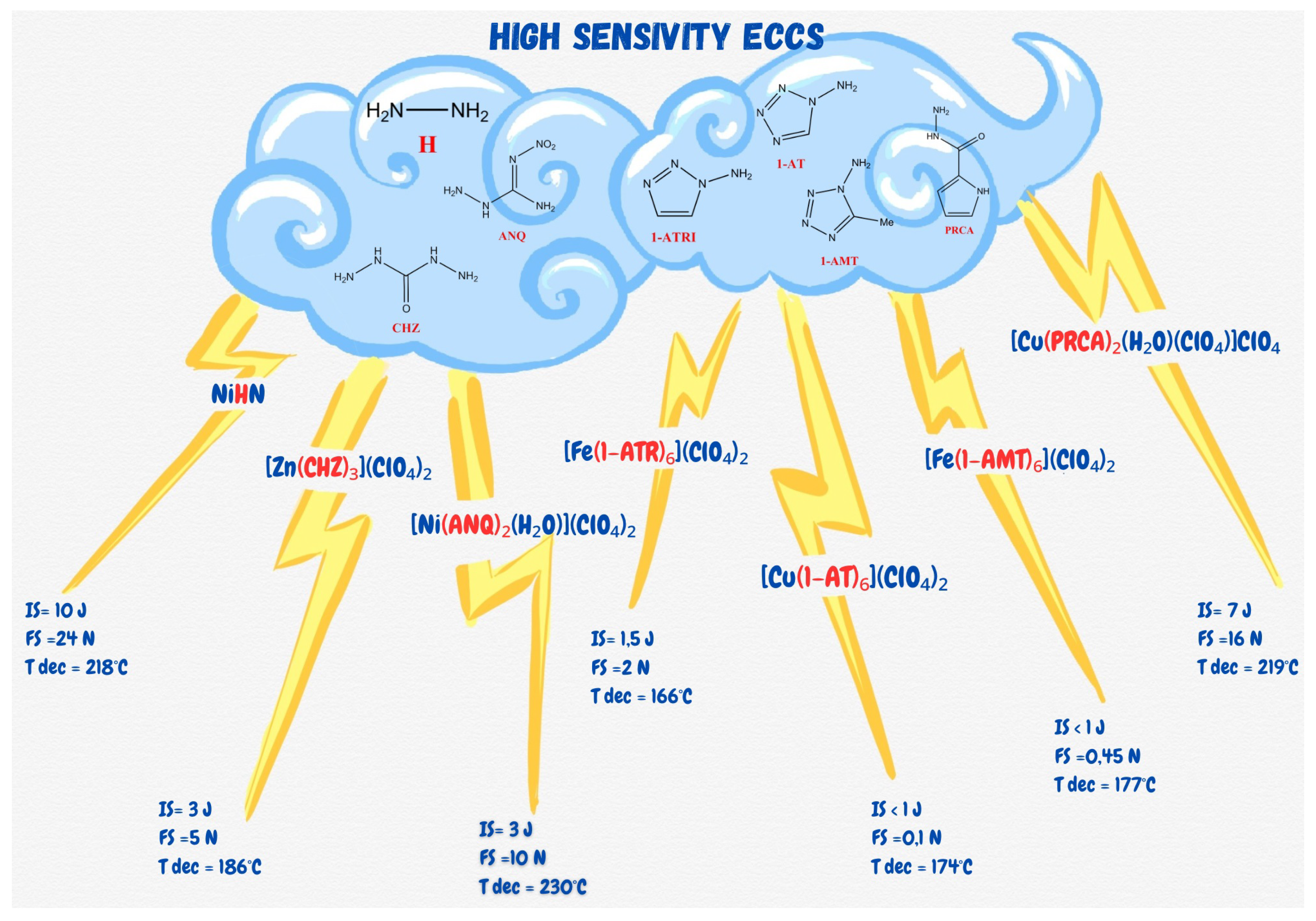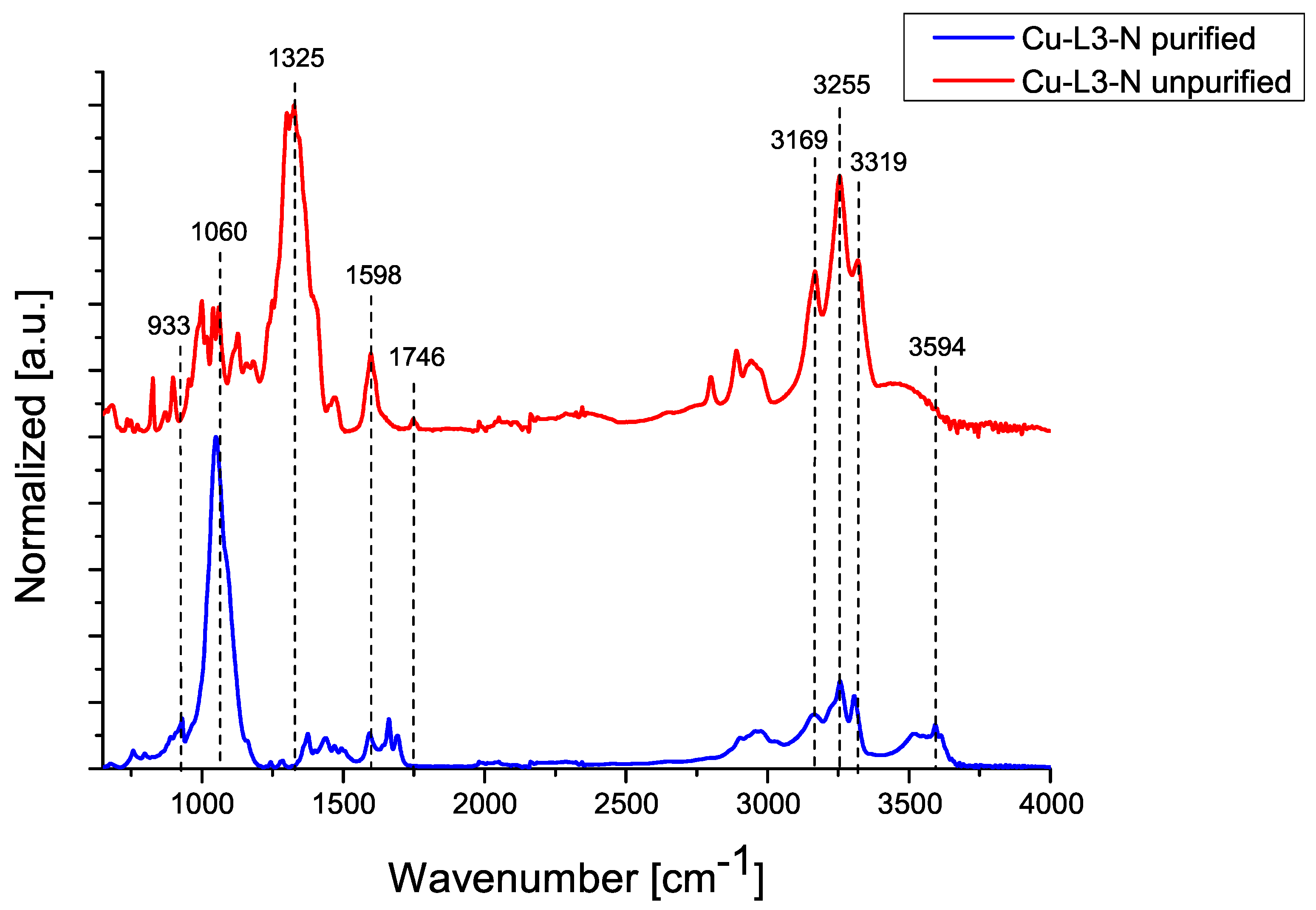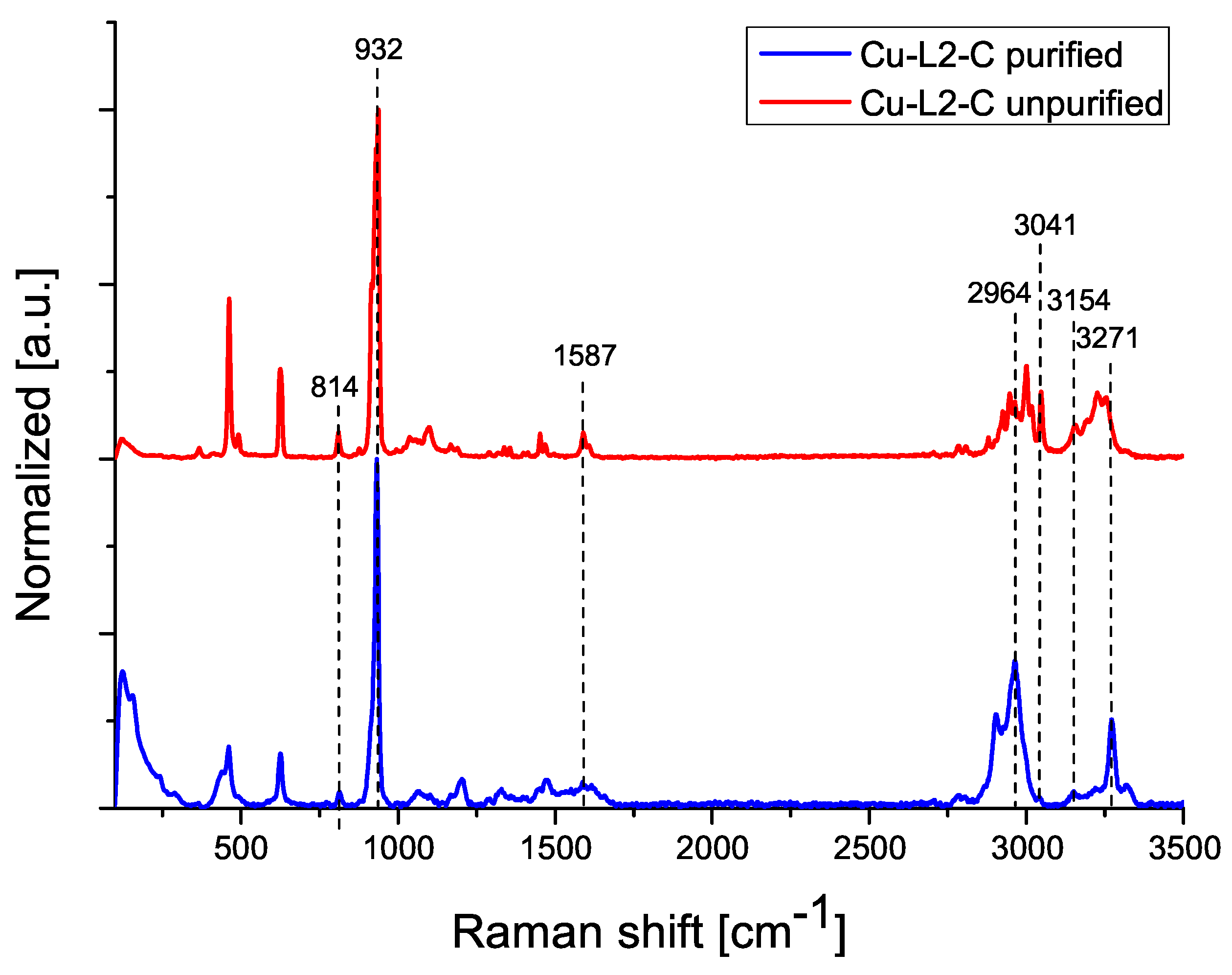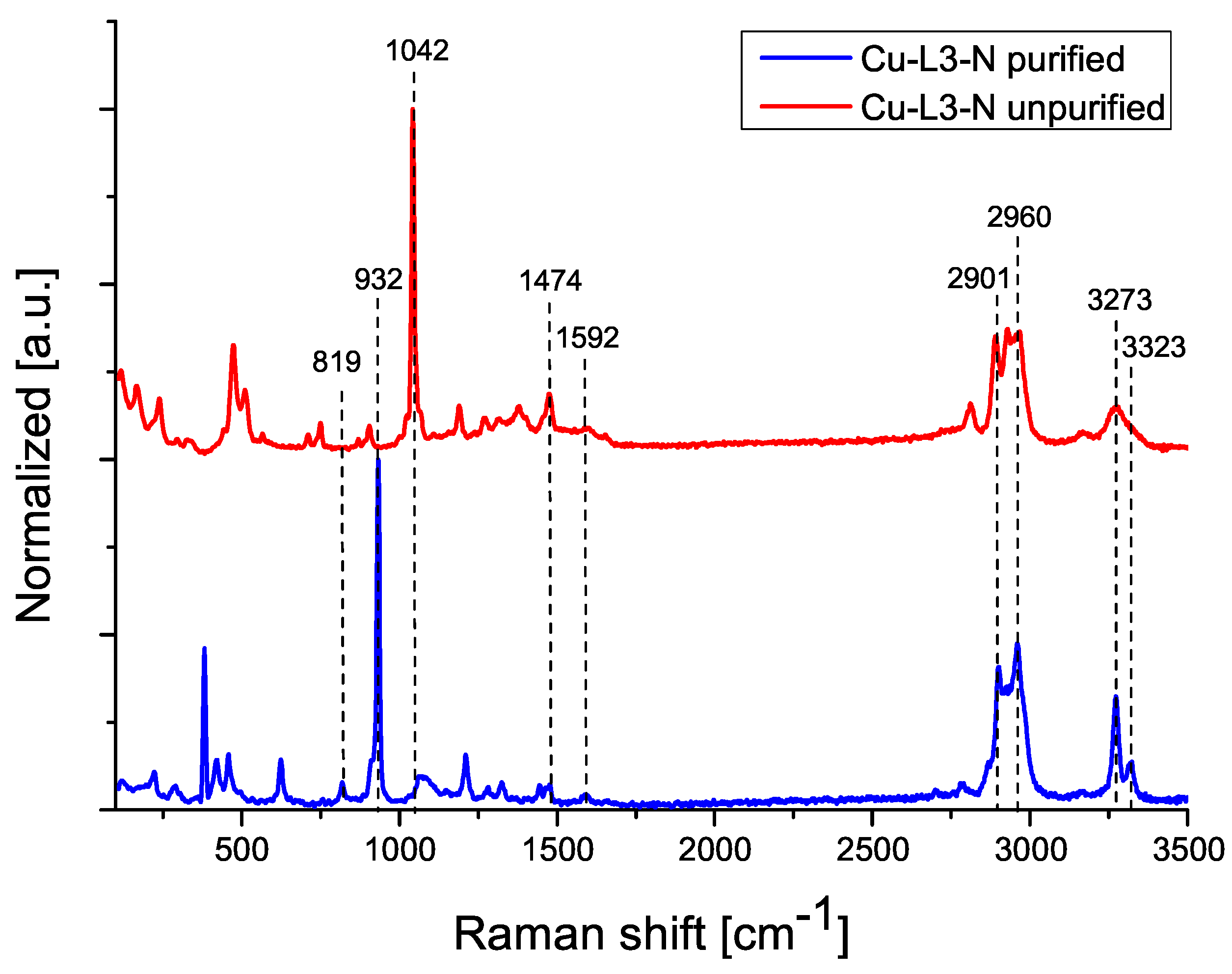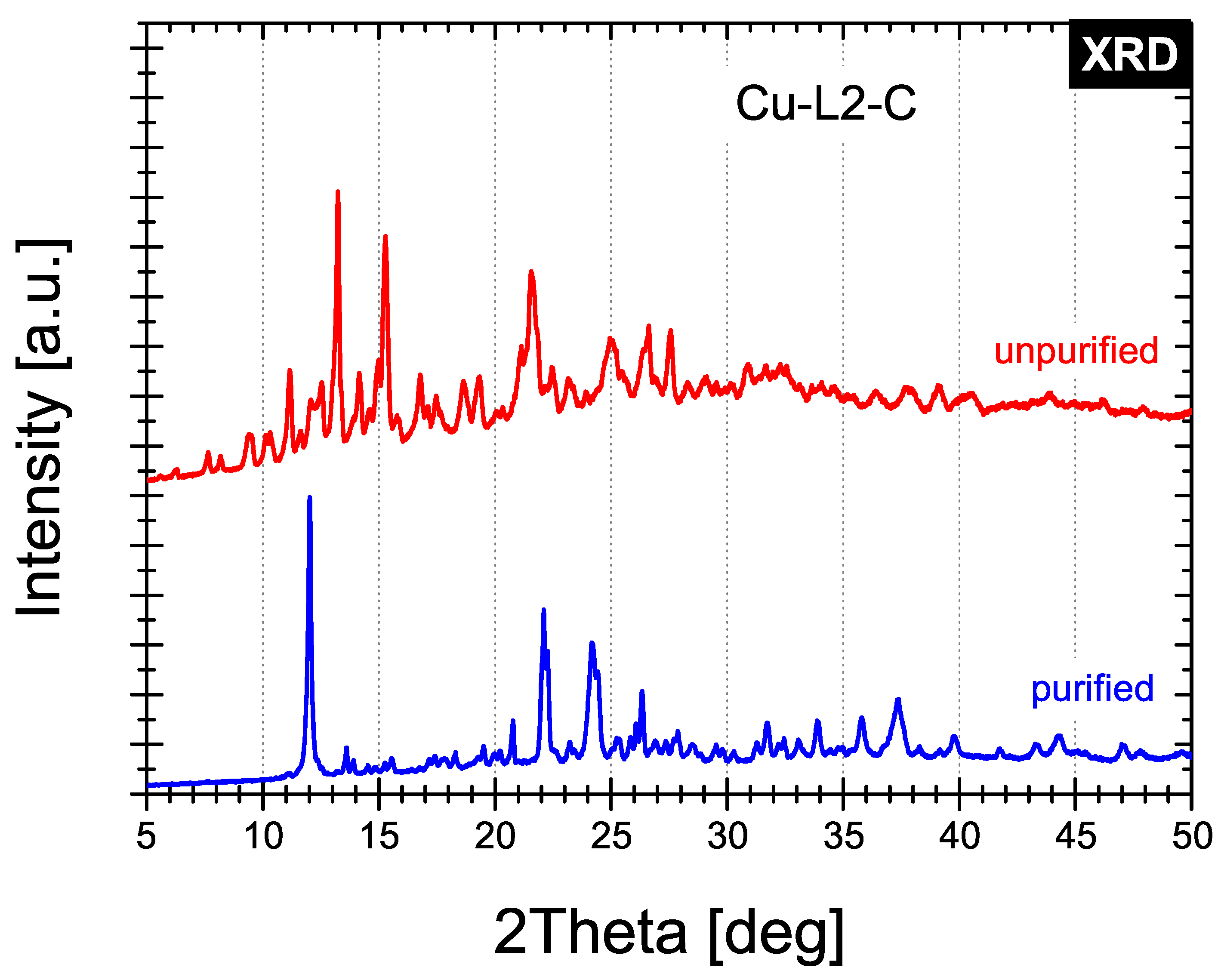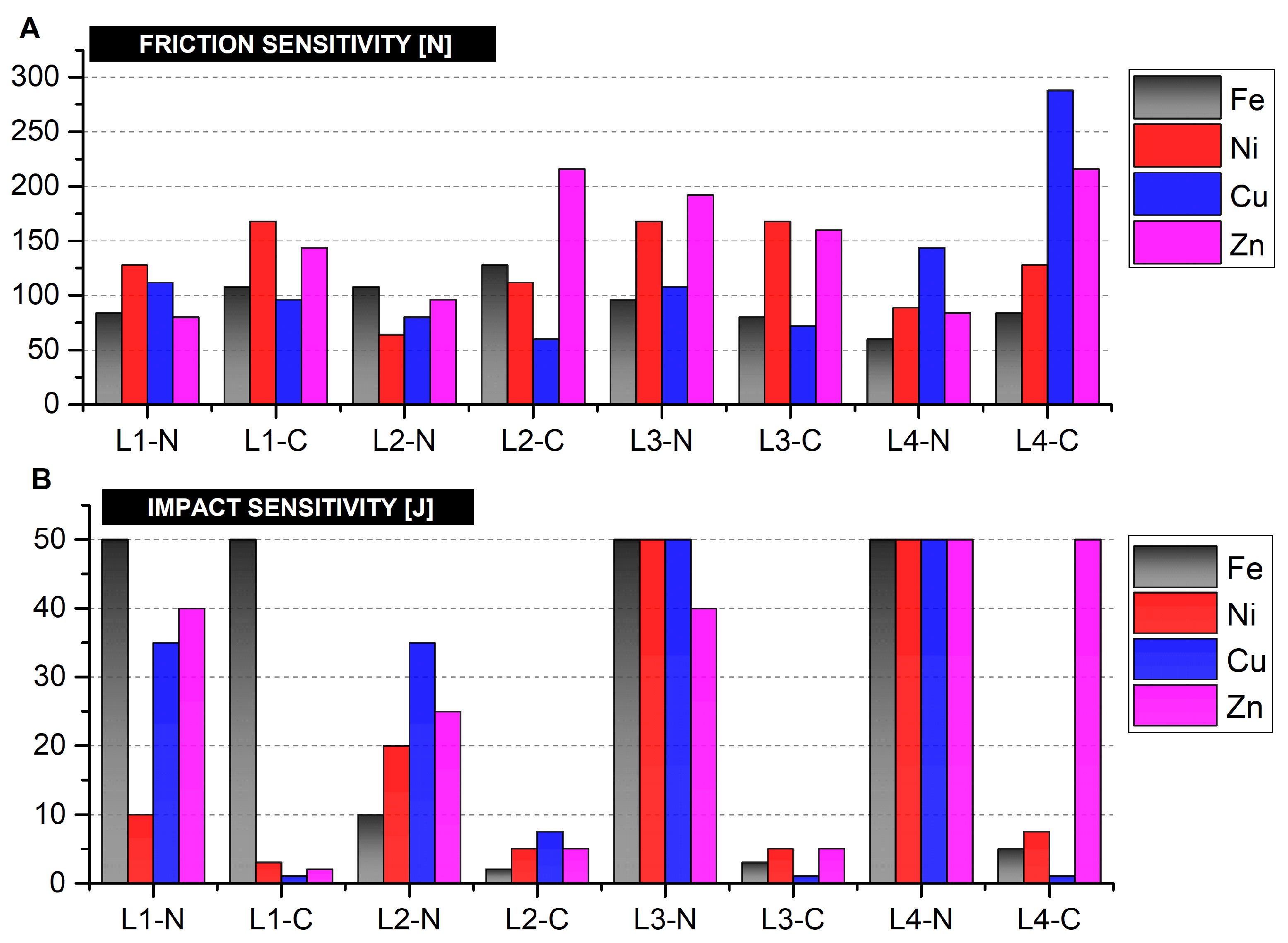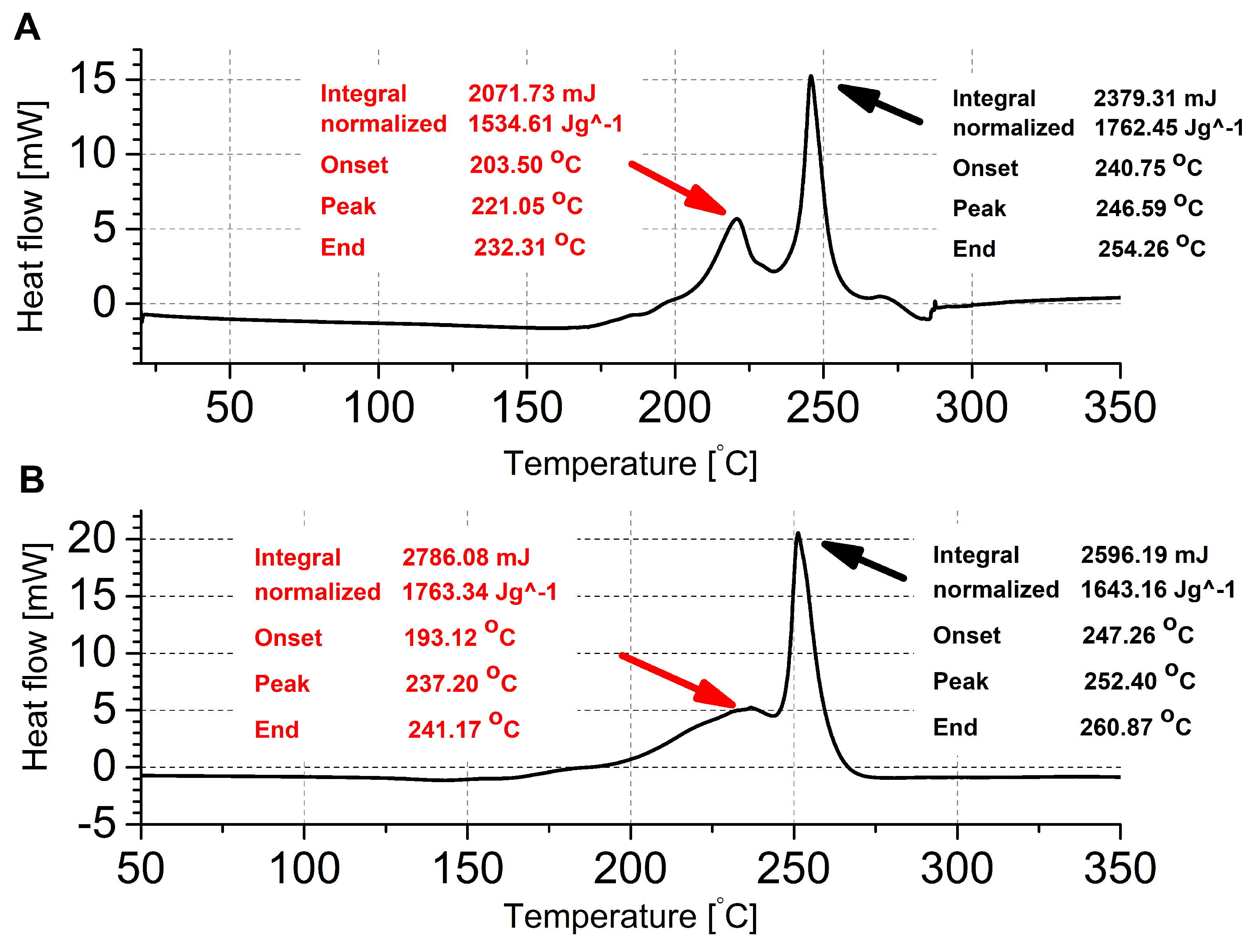Appendix A
Table A1.
Chemicals used in the syntheses of ECCs.
Table A1.
Chemicals used in the syntheses of ECCs.
| Chemical | Purity [%] | Source |
|---|
| Iron(III) nitrate nonahydrate | ≥98 | Sigma-Aldrich |
| Nickel(II) nitrate hexahydrate | ≥98.5 | Sigma-Aldrich |
| Copper(II) nitrate hemi(pentahydrate) | >98 | Sigma-Aldrich |
| Zinc nitrate hexahydrate | >98 | Sigma-Aldrich |
| Iron(II) perchlorate hydrate | >98 | Sigma-Aldrich |
| Nickel(II) perchlorate hexahydrate | >98 | Sigma-Aldrich |
| Copper(II) perchlorate hexahydrate | >98 | Sigma-Aldrich |
| Zinc perchlorate hexahydrate | >98 | Sigma-Aldrich |
| 1,2-ethylenediamine | >99 | Chemsolve |
| 1,3-diaminopropane | >98 | TCI |
| Tris(2-aminoethyl)amine | >98 | TCI |
| Tris(3-aminopropyl)amine | >97 | TCI |
| Ethanol 96% | cz. d. a. | Stanlab |
Table A2.
Sample codes corresponding to synthesized energetic coordination compounds in configuration M-L-A (where M—metal; L—ligand; A—oxidizing anion; N indicates NO3−, C indicates ClO4−).
Table A2.
Sample codes corresponding to synthesized energetic coordination compounds in configuration M-L-A (where M—metal; L—ligand; A—oxidizing anion; N indicates NO3−, C indicates ClO4−).
| Metal | Ligand |
|---|
| EDA | DP | TAEA | TAPA |
|---|
| Fe | Fe-L1-N | Fe-L2-N | Fe-L3-N | Fe-L4-N |
| Fe-L1-C | Fe-L2-C | Fe-L3-C | Fe-L4-C |
| Ni | Ni-L1-N | Ni-L2-N | Ni-L3-N | Ni-L4-N |
| Ni-L1-C | Ni-L2-C | Ni-L3-C | Ni-L4-C |
| Cu | Cu-L1-N | Cu-L2-N | Cu-L3-N | Cu-L4-N |
| Cu-L1-C | Cu-L2-C | Cu-L3-C | Cu-L4-C |
| Zn | Zn-L1-N | Zn-L2-N | Zn-L3-N | Zn-L4-N |
| Zn-L1-C | Zn-L2-C | Zn-L3-C | Zn-L4-C |
Table A3.
Amount of reagents used for synthesis of ECCs based on 1,2-ethylenediamine and yields achieved.
Table A3.
Amount of reagents used for synthesis of ECCs based on 1,2-ethylenediamine and yields achieved.
| Metal Salt | Amount of Reagent | Yield [%] |
|---|
| Metal Salt | Ligand | H2O |
|---|
| 0.96 g (2.39 mmol) | 0.48 g (7.11 mmol) | 23.7 cm3 | 75 |
| 0.80 g (2.76 mmol) | 0.55 g (8.27 mmol) | 27.6 cm3 | 77 |
| 0.76 g (3.25 mmol) | 0.43 g (9.75 mmol) | 32.5 cm3 | 76 |
| 0.81 g (2.71 mmol) | 0.54 g (8.12 mmol) | 27.1 cm3 | 61 |
| 0.70 g (1.87 mmol) | 0.38 g (5.62 mmol) | 18.7 cm3 | 85 |
| 0.84 g (2.29 mmol) | 0.46 g (6.86 mmol) | 26.1 cm3 | 91 |
| 0.97 g (2.61 mmol) | 0.35 g (7.84 mmol) | 26.1 cm3 | 90 |
| 0.84 g (2.25 mmol) | 0.45 g (6.75 mmol) | 22.5 cm3 | 93 |
Table A4.
Amount of reagents used for synthesis of ECCs based on 1,3-diaminopropane and yields achieved.
Table A4.
Amount of reagents used for synthesis of ECCs based on 1,3-diaminopropane and yields achieved.
| Metal Salt | Amount of Reagent | Yield [%] |
|---|
| Metal Salt | Ligand | H2O |
|---|
| 0.64 g (1.60 mmol) | 0.28 g (3.19 mmol) | 16.0 cm3 | 79 |
| 0.57 g (1.95 mmol) | 0.34 g (3.90 mmol) | 19.5 cm3 | 82 |
| 0.61 g (2.63 mmol) | 0.30 g (5.25 mmol) | 26.3 cm3 | 81 |
| 0.57 g (1.92 mmol) | 0.33 g (3.85 mmol) | 19.2 cm3 | 79 |
| 0.63 g (1.68 mmol) | 0.29 g (3.36 mmol) | 16.8 cm3 | 97 |
| 0.62 g (1.70 mmol) | 0.30 g (3.40 mmol) | 17.0 cm3 | 84 |
| 0.71 g (1.93 mmol) | 0.22 g (3.85 mmol) | 19.3 cm3 | 85 |
| 0.63 g (1.68 mmol) | 0.29 g (3.36 mmol) | 16.8 cm3 | 82 |
Table A5.
Amount of reagents used for synthesis of ECCs based on tris(2-aminoethyl)amine and yields achieved.
Table A5.
Amount of reagents used for synthesis of ECCs based on tris(2-aminoethyl)amine and yields achieved.
| Metal Salt | Amount of Reagent | Yield [%] |
|---|
| Metal Salt | Ligand | H2O |
|---|
| 0.76 g (1.87 mmol) | 0.58 g (3.74 mmol) | 18.7 cm3 | 87 |
| 0.61 g (2.10 mmol) | 0.66 g (4.21 mmol) | 21.0 cm3 | 89 |
| 0.61 g (2.61 mmol) | 0.54 g (5.23 mmol) | 26.1 cm3 | 92 |
| 0.62 g (2.08 mmol) | 0.65 g (4.15 mmol) | 20.8 cm3 | 86 |
| 0.58 g (1.55 mmol) | 0.48 g (3.09 mmol) | 15.5 cm3 | 91 |
| 0.66 g (1.82 mmol) | 0.57 g (3.64 mmol) | 18.2 cm3 | 90 |
| 0.81 g (2.19 mmol) | 0.45 g (4.37 mmol) | 21.9 cm3 | 94 |
| 0.67 g (1.80 mmol) | 0.56 g (3.59 mmol) | 18.0 cm3 | 88 |
Table A6.
Amount of reagents used for synthesis of ECCs based on tris(3-aminopropyl)amine and yields achieved.
Table A6.
Amount of reagents used for synthesis of ECCs based on tris(3-aminopropyl)amine and yields achieved.
| Metal Salt | Amount of Reagent | Yield [%] |
|---|
| Metal Salt | Ligand | H2O |
|---|
| 0.52 g (1.28 mmol) | 0.52 g (2.56 mmol) | 12.8 cm3 | 95 |
| 0.44 g (1.50 mmol) | 0.61 g (3.00 mmol) | 15.0 cm3 | 86 |
| 0.48 g (2.07 mmol) | 0.56 g (4.13 mmol) | 20.7 cm3 | 98 |
| 0.44 g (1.48 mmol) | 0.60 g (2.97 mmol) | 14.8 cm3 | 89 |
| 0.50 g (1.34 mmol) | 0.54 g (2.67 mmol) | 13.4 cm3 | 91 |
| 0.49 g (1.35 mmol) | 0.55 g (2.69 mmol) | 13.5 cm3 | 88 |
| 0.60 g (1.61 mmol) | 0.44 g (3.22 mmol) | 16.1 cm3 | 77 |
| 0.50 g (1.34 mmol) | 0.54 g (2.67 mmol) | 13.4 cm3 | 91 |
Table A7.
Friction and impact sensitivity values for synthesized ECCs.
Table A7.
Friction and impact sensitivity values for synthesized ECCs.
| Oxidizing Anion: NO3− | Oxidizing Anion: ClO4− |
|---|
| Sample Code | FS [N] | IS [J] | Sample Code | FS [N] | IS [J] |
| Fe-L1-N | 84 | >50 | Fe-L1-C | 108 | >50 |
| Ni-L1-N | 128 | 10 | Ni-L1-C | 168 | 3 |
| Cu-L1-N | 112 | 35 | Cu-L1-C | 96 | <1 |
| Zn-L1-N | 80 | 40 | Zn-L1-C | 144 | 2 |
| Fe-L2-N | 108 | 10 | Fe-L2-C | 128 | 2 |
| Ni-L2-N | 64 | 20 | Ni-L2-C | 112 | 5 |
| Cu-L2-N | 80 | 35 | Cu-L2-C | 60 | 7.5 |
| Zn-L2-N | 96 | 25 | Zn-L2-C | 216 | 5 |
| Fe-L3-N | 96 | >50 | Fe-L3-C | 80 | 3 |
| Ni-L3-N | 168 | >50 | Ni-L3-C | 168 | 5 |
| Cu-L3-N | 108 | >50 | Cu-L3-C | 72 | <1 |
| Zn-L3-N | 192 | 40 | Zn-L3-C | 160 | 5 |
| Fe-L4-N | 60 | >50 | Fe-L4-C | 84 | 5 |
| Ni-L4-N | 89 | >50 | Ni-L4-C | 128 | 7.5 |
| Cu-L4-N | 144 | >50 | Cu-L4-C | 288 | 1 |
| Zn-L4-N | 84 | >50 | Zn-L4-C | 216 | >50 |
Table A8.
Number of pressing operations for preparation of detonators.
Table A8.
Number of pressing operations for preparation of detonators.
| Type | Secondary EM | Mass mg | Steps | Primary EM | Mass mg | Steps |
|---|
| Z1 | Cu-L1-N | 800 | 2 | PbN6 | 300 | 1 |
| Z2 | Cu-L1-C | 800 | 2 | PbN6 | 300 | 1 |
| Z3 | Cu-L2-N | 800 | 2 | PbN6 | 300 | 1 |
| Z4 | Cu-L2-C | 800 | 2 | PbN6 | 300 | 1 |
| Z5 | Cu-L3-N | 800 | 2 | PbN6 | 300 | 1 |
| Z6 | Cu-L3-C | 800 | 2 | PbN6 | 300 | 1 |
Table A9.
Values of the: tb, ES, ESW, EB, EBW for reference EMs and containing ECCs.
Table A9.
Values of the: tb, ES, ESW, EB, EBW for reference EMs and containing ECCs.
| Sample Code | m [g] | t b [ms] | ES·108 [Pa2s] | ESW [J] | EB·10−6 [s3] | EBW [J] |
|---|
| PETN | 0.6 | 21.21 (±0.11) | 4.63 (±0.11) | 629 (±15) | 9.54 (±0.13) | 770 (±10) |
| 0.8 | 22.44 (±0.10) | 5.77 (±0.20) | 785 (±27) | 11.30 (±0.16) | 911 (±13) |
| 1.0 | 23.43 (±0.21) | 6.80 (±0.21) | 925 (±29) | 12.86 (±0.34) | 1038 (±28) |
| Cu-L1-C | 0.8 | 20.86 (±0.04) | 2.54 (±0.04) | 345 (±5) | 9.08 (±0.19) | 733 (±15) |
| Cu-L2-C | 0.8 | 21.16 (±0.15) | 2.95 (±0.06) | 402 (±9) | 9.48 (±0.20) | 765 (±16) |
| Cu-L3-C | 0.8 | 21.51 (±0.04) | 2.31 (±0.05) | 314 (±7) | 9.95 (±0.06) | 803 (±5) |
Figure A1.
IR-ATR spectra for energetic coordination compounds containing 1,2-ethylenediamine and nitrate salts.
Figure A1.
IR-ATR spectra for energetic coordination compounds containing 1,2-ethylenediamine and nitrate salts.
Figure A2.
IR-ATR spectra for energetic coordination compounds containing 1,2-ethylenediamine and perchlorate salts.
Figure A2.
IR-ATR spectra for energetic coordination compounds containing 1,2-ethylenediamine and perchlorate salts.
Figure A3.
IR-ATR spectra for energetic coordination compounds containing 1,3-diaminopropane and nitrate salts.
Figure A3.
IR-ATR spectra for energetic coordination compounds containing 1,3-diaminopropane and nitrate salts.
Figure A4.
IR-ATR spectra for energetic coordination compounds containing 1,3-diaminopropane and perchlorate salts.
Figure A4.
IR-ATR spectra for energetic coordination compounds containing 1,3-diaminopropane and perchlorate salts.
Figure A5.
IR-ATR spectra for energetic coordination compounds containing tris(2-aminoethyl)amine and nitrate salts.
Figure A5.
IR-ATR spectra for energetic coordination compounds containing tris(2-aminoethyl)amine and nitrate salts.
Figure A6.
IR-ATR spectra for energetic coordination compounds containing tris(2-aminoethyl)amine and perchlorate salts.
Figure A6.
IR-ATR spectra for energetic coordination compounds containing tris(2-aminoethyl)amine and perchlorate salts.
Figure A7.
IR-ATR spectra for energetic coordination compounds containing tris(3-aminopropyl)amine and nitrate salts.
Figure A7.
IR-ATR spectra for energetic coordination compounds containing tris(3-aminopropyl)amine and nitrate salts.
Figure A8.
IR-ATR spectra for energetic coordination compounds containing tris(3-aminopropyl)amine and perchlorate salts.
Figure A8.
IR-ATR spectra for energetic coordination compounds containing tris(3-aminopropyl)amine and perchlorate salts.

